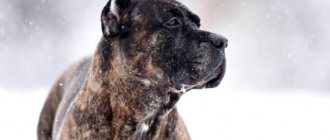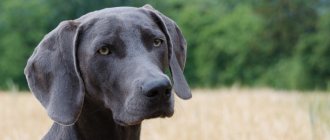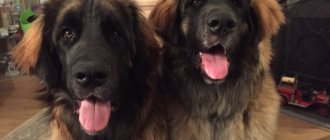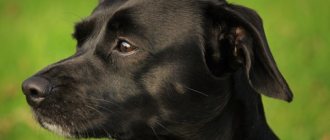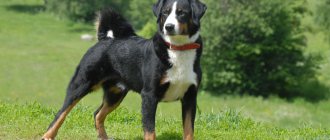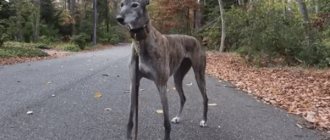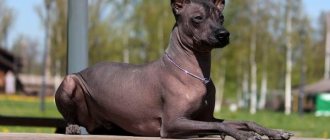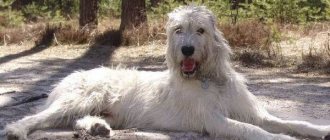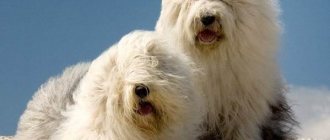The Dogue de Bordeaux or French Mastiff is a large, massive dog with an impressive appearance, but cheerful and good-natured. Capable of becoming a devoted and loving friend, as well as a faithful watchman or bodyguard. Dogues de Bordeaux were bred in the past as fighting and guard dogs. Although now there is almost no aggression left in their character, the breed is not recommended for beginners. These strong, fearless dogs have gained popularity due to their selfless devotion to their owner, calm disposition and formidable appearance. Before you get a French Mastiff, you should study the description of the breed, get acquainted with photographs and videos. Reviews from owners will help you understand the pros and cons of these dogs and the features of their maintenance.
- Head
- Education and training
- Hygiene procedures
Breed traits
Breed traits (on a 5-point scale)
| Dogue de Bordeaux (French Mastiff) | |||
| Activity | in the house | 3.5 | |
| on the street | 4 | ||
| Obedience | training | 3.2 | |
| strangers | 1 | ||
| Domination | in family | 2 | |
| over dogs | 3.8 | ||
| Defending your territory | from people | 4.4 | |
| from dogs | 4.6 | ||
| Sociability | in family | 3 | |
| with strangers | 1 | ||
| with dogs | 3.1 | ||
| Concentration | in family | 3 | |
| in front of strangers | 3.1 | ||
| with dogs | 3.4 | ||
| Aggressiveness | in family | 1.5 | |
| to strangers | 5 | ||
| to the dogs | 4.8 | ||
| to cats | 3.5 | ||
| Family behavior | calmness | 3.5 | |
| demand for affection | 2 | ||
| excitability | 2.6 | ||
| playfulness | 2.1 | ||
| excessive barking | 2 | ||
| behavioral breakdowns | 2.8 | ||
| Tolerance for children | up to 4 years | 2.5 | |
| over 4 years old | 2.2 | ||
| Institutional use | watchman | 4.2 | |
| bodyguard | 4.6 | ||
This breed is often compared to the following dog breeds: Bullmastiff, Cane Corso, Mastino Neapolitano (Neapolitan Mastiff), Rottweiler, English Mastiff.
The photo shows what Dogues de Bordeaux look like:
Breed price
This breed is rarely found in Russia. Therefore, it is possible to buy a Dogo Canary somewhere other than Moscow, but with great difficulty. You can search for advertisements on the Internet. Sometimes you can find offers from breeders on the Internet.
However, they are quickly disappearing due to strong demand. Another option is visiting exhibitions and other events with the participation of four-legged friends. Perhaps one of the dog breeders will suggest an option for purchasing this animal.
Since the breed is rare, its cost is high. The price of a Dogo Canario varies between 1000-1500 dollars. You can find offers with a price list 100-200 conventional units lower than the indicated price.
But it is not a fact that the dog will be a purebred Canarian. And if we are talking about the rich pedigree of the dog’s parents, then the price tag may be twice as high as the standard one. But this will not be the limit.
To choose a healthy pet, you need to take a closer look at the entire litter. The most active and playful, as a rule, turns out to have high immunity. The breeder will also be able to provide some advice. The best age for moving a puppy to a new family is 2.5 - 3.5 months.
General characteristics of the breed
Dogues de Bordeaux are excellent guard dogs. This is one of the ancient breeds common in France. Previously, its representatives were used for dog fighting, guarding farms and castles. This is a large dog with a powerful build and a wide muzzle covered with many folds.
The Dogue de Bordeaux is called the French Mastiff or Bordeaux. These dogs appear in films and became popular in the world after the film Turner and Hooch. In our country they have received a reputation as ferocious and aggressive animals, but this is undeserved. Although this is truly a vigilant watchman, resolutely protecting the territory from any encroachment. Boldly rushes to the defense of the owner. And since they were fighting dogs in the past, they can cause serious harm. If raised incorrectly, a dog can become uncontrollable and dangerous.
But in fact, these dogs are not aggressive and rush at a person only when there is a serious threat from him. And the rest of the time he is an affectionate and good-natured companion, a loyal friend. They have a calm, phlegmatic character, are silent and slow, and love to sleep.
| Options | Characteristic |
| breed name | Dogue de Bordeaux (French: Dogue de Bordeaux), Bordeaux Mastiff or French Mastiff |
| a country | France |
| group of breeds according to the ICF classification | Pinschers and Schnauzers, Molossians, Mountain and Swiss Cattle Dogs, Mastiff subsection |
| application | watchman, bodyguard, companion |
| life expectancy | 9-11 years |
| height | male 60-68 cm, female 58-66 cm |
| weight | male from 50 kg, female from 45 kg |
| character traits | calm, balanced, devoted, fearless |
| aggressiveness | low |
| activity | average |
| intelligence | standard |
| training | complex |
| attitude towards a person | loyal to the owner, good-natured with all family members, suspicious of strangers |
| content | in an apartment, private house |
| difficulty of care | simple |
pros
The Dogue de Bordeaux is bred as a watchman, security guard and companion. Despite its large size, it can be kept in an apartment; it is not very active and likes to sleep. With enough attention from the owners, he will not chew things and damage furniture. This dog has several more advantages:
- has innate protective qualities;
- loyal to the owner, strongly attached to all family members;
- affectionate and loving;
- balanced, calm;
- with the right approach, it is easy to train, as it quickly remembers commands;
- not noisy;
- not aggressive;
- patient with children;
- gets along with other pets;
- hardy and unpretentious, does not require serious care
Minuses
The Dogue de Bordeaux is not a breed for everyone. Beginners should not get this dog, as they may not be able to handle the training. In the absence of timely socialization and proper upbringing, she can grow up aggressive and uncontrollable. These dogs are not suitable for people who work a lot and will not be able to pay enough attention to them. And due to its large size, Bordeaux will be uncomfortable in a small apartment.
There are several other disadvantages to keeping these dogs that can cause problems:
- do not tolerate loneliness well;
- drool and snore frequently;
- get into conflicts with unfamiliar dogs;
- can be stubborn and vindictive;
- cannot stand the smell of alcohol and can attack a drunk person;
- have weak joints and low life expectancy;
- lazy and sedentary, prone to obesity.
The video complements the description of this breed:
Video: Dogue de Bordeaux. Pros and cons, price, how to choose, facts, care, history
Video: Dogue de Bordeaux (first-hand advice)
Similar breeds
Dogues de Bordeaux are similar to the Bullmastiff and Canne Corso. These are breeds from the Molosser group. Bordeaux differs from the Bullmastiff in the following characteristics:
- larger;
- a dark mask is not required on the face;
- ears are larger.
The Cane Corso, unlike the Bordeaux, has a more graceful physique; the ears and tail should be cropped, and the folds on the muzzle are less pronounced. These are active, playful dogs, slightly smaller in size.
The photographs show the differences between these dogs and representatives of other breeds:
Bullmastiff on the left, Dogue de Bordeaux (French Mastiff) on the right
Bullmastiff:
Bullmastiff
Cane Corso:
Cane Corso
Character of the Dogo Canario
Presa Canarios are no longer gladiators or game hunters, but their territorial instinct is still strong. That is why it is better to acquire a Dogo Canary when there is a need for a protector and a sensitive watchman. In everyday life, tiger “jocks” are quite balanced and calm, but they do not fall out of reality, preferring to keep the situation under control. Hence - distrust of strangers and suspicion of everyone who tries to come into close contact with the owner. In relations with fellow tribesmen, Canary Dogoes are reasonable and restrained, but only until the first provocation. Once the intensity of passion reaches its peak, it is impossible to stop the dog.
Attacking without warning is not in the rules of Presa Canario, so if the animal growls, stands up and shows its fangs, this signals that it is time to immediately retreat. It is generally not recommended to run away from the natives of Tenerife unless you want to provoke the dog to more radical measures. Dogo Canarios have a peaceful and trusting relationship with children. A formidable “bodyguard” can do a lot for kids, so if you see a dog pushing kids on a sled, this is not a staged show, but a completely ordinary occurrence for a family in which the dog and children trust each other. However, you shouldn’t rely recklessly on the animal’s patience: for all their love of children, Canary Dogs are not among the top four-legged nannies that you can leave your kids with.
The breed does not compete with other pets for spheres of influence, especially if these same pets are smaller in size than Great Danes. When getting a Presa Canario puppy, it is not necessary to evict cats and dogs of decorative breeds from your home. Living side by side, the animals gradually get used to each other and do not conflict. Dogo Canarios prefer to find out who is boss in the house among themselves, so if you plan to become the owner of two males or females, prepare for friction between your charges. In everyday life, the descendants of Roman Molossians are unpretentious; if the owner has no desire to communicate, they easily blend into the interior. Another distinctive character trait of the breed is slight stubbornness, which you just need to accept.
History of the origin of the Dogue de Bordeaux breed
There is still debate about the origin of this dog breed. The ancestors are called Tibetan mastiffs, bulldogs and ancient French Alans. These are fighting dogs, common many centuries ago in France and Spain. They were used for hunting wild boars and large predators, for guarding, and also for dog fighting. They had a powerful grip, a fearless character and a strong, resilient body.
These dogs were called French Mastiffs. When dog fighting was banned in the mid-19th century, dog breeders became interested in the breed. In 1863, a dog from Bordeaux was first presented at an exhibition. Active breeding work has begun. The breed was named Dogue de Bordeaux. Veterinarian Pierre Meignen developed the first standard. According to him, these dogs had to have a uniform color without a dark mask or spots.
The breed's population declined greatly at the beginning of the 20th century due to two World Wars. It was difficult to feed such large animals. Bordeaux preserved only in French Aquitaine. The restoration of the breed began in the second half of the 20th century. It was only in the 70s that it was officially registered with the FCI and a new standard was created. The French mastiff came to Russia in the 90s of the 20th century, but has not yet become popular.
Possible diseases
This dog arose thanks to natural selection. And since it is not artificially bred, genetic and hereditary diseases are minimized.
But, like most large dogs, the Dogo Canario breed can have problems with the musculoskeletal system. We are talking about dysplasia of the elbow and hip joints. Ailments of the gastrointestinal tract are also possible; intestinal and stomach volvulus are especially popular.
The Dogo Canario has sharp teeth and a large mouth
The most popular nervous system disorder is epileptic seizures. In addition, dogs are susceptible to infectious diseases. Prevention will include timely vaccination and visiting the veterinarian’s office at least once every six months.
Special collars and sprays will help against seasonal parasites such as ticks and fleas. From time to time it is worth carrying out deworming. With proper care for dogs, their average life expectancy will be from 9 to 12-13 years.
Appearance standards for Dogue de Bordeaux
This dog's appearance is remarkable: a squat, muscular body covered with short red hair, a large head, a wide short muzzle with many folds. She is characterized by a slightly sad look and the ability to control facial muscles. This is a fairly large dog, the height at the withers is on average 66-68 cm. And the weight of Dogue de Bordeaux males can reach 60-90 kg, females weigh on average 45-50 kg.
Head
The head is large, the muzzle is short and wide. When viewed from the front, it has a square shape. The stop is clearly defined, with symmetrical folds radiating from the middle of the forehead. The brow ridges and cheekbones are massive. The cheeks are thick, drooping, with prominent jowls. The upper lips form an inverted V.
The jaws are powerful, the lower one protrudes slightly forward, but the teeth are not visible. Representatives of the breed are characterized by snacking. The nose is slightly upturned, but not flattened, the nostrils are wide, and the nose is colored black. But the standard also allows liver or reddish color.
The eyes are small, almond-shaped, set wide and slightly oblique. Color – light brown, nut or dark brown. The look is open, attentive and a little thoughtful. The ears are small, drooping, and fit tightly to the cheekbones. Set wide and high, triangular in shape with slightly rounded tips.
Frame
The dog's build is strong, stocky, but harmonious. The neck is short, muscular, with dewlap. The convex scruff merges into the raised withers. The chest is deep and wide. The abdomen is moderately tucked. The back is wide, straight, the lower back is convex.
The tail is thick at the base and set high. Hangs below the hocks. When the dog runs, raises it to the level of the back. But he never twists it into a ring or throws it over his lower back.
Limbs
The forelimbs are massive, straight, set parallel. The elbows are pressed tightly to the chest, the shoulder blades are located at right angles, the pasterns are slightly turned outward. The thighs are powerful, muscular, and the hocks are set low. Provides a strong push. The paws are compact, the toes with elastic pads are gathered into a ball. The dog moves with a sweeping, free, easy trot.
Coat and color
The skin of representatives of the breed is thick and elastic. Forms numerous folds, especially noticeable on the head and neck. The coat is very short, thick, without undercoat. The hairs are soft and thin, lying tightly to the body.
The color of the Dogue de Bordeaux should be uniform - these are any shades of red: sand, reddish, brown, chestnut, yellowish. The standard allows small white spots on the chest and fingers. There may be a darker mask on the muzzle.
Disqualifying faults
Even a slight deviation from the standard will disqualify the dog. She will not be allowed for exhibitions and breeding if she has the following deficiencies:
- straight or scissor bite;
- strongly tucked or straight abdominal line;
- thin limbs with unexpressed muscles;
- close-set eyes;
- heavy gait;
- Long neck;
- hunchback or sagging back;
- bulldog-shaped head or overbite;
- long muzzle;
- white spots on the head and body;
- short upper lips revealing fangs.
Photos complement the description of appearance:
Health and diseases of Dogo Canarios
The most common disease of Dogo Canarios is hip and elbow dysplasia. The disease is inherited from parents, so early diagnosis of producers is an important nuance that should not be overlooked. Sometimes representatives of the breed are diagnosed with Wobbler syndrome, epilepsy and multifocal retinopathy, but this does not happen as often as in the case of dysplasia. Another important feature of Presa Canario is its tendency to volvulus of the intestines and stomach. This is usually due to overfeeding, as well as non-compliance with the regime (walking and sports training immediately after eating). Otherwise, Canary Dogs are quite healthy and strong creatures, with careful care they live no less than other large breeds, that is, up to 10-12 years.
Character of the Dogue de Bordeaux
The Dogue de Bordeaux has an intimidating appearance. Those who do not know the character traits of these dogs consider them angry and aggressive. In fact, this is a good-natured, loving and affectionate pet. Usually it chooses one owner and remains faithful to him. He listens only to a strong-willed person who has been able to gain authority.
He does not tolerate separation from his owner well and tries to constantly be near him. Follows a person on his heels, loves to lie on the couch with him. On the street he also tries not to leave his owner’s side. He gets very bored when alone and can ruin things. He becomes attached to all family members, affectionate and friendly with them. This dog is ready to protect them from any danger. Has a tendency to manipulate and can be cunning.
Dogues de Bordeaux have the following character traits:
- slowness;
- restraint;
- vigilance;
- observation;
- devotion;
- sociability;
- stubbornness.
The French Mastiff treats children with care and loves to play with them. Protects them, patiently endures pranks. But you shouldn’t leave such a large dog alone with kids - it can accidentally drop or crush the child. It is better for this dog to communicate with children over 7 years old.
It gets along with other pets only with proper upbringing and timely socialization. Can live quietly next to a cat or small dog and will protect them. But on the street, Bordeaux dogs often chase cats or birds due to their heightened hunting instinct, so it is better not to let them off the leash.
The Dogue de Bordeaux is more of a bodyguard than a watchman. He has a poorly developed territorial sense. This dog rarely barks and can easily let a stranger into a house or property. It attacks only when there are obvious signs of aggression or if it senses a danger to its family members. First, he will try to scare the stranger with a menacing look and growl. Protecting the members of his family, the French Dogo will fight to the last.
The peculiarity of representatives of this breed is intolerance to the smell of alcohol. When walking with Bordeaux, you need to avoid places where there may be drunk people. The dog can rush, and in this case it is very difficult to keep him on a leash.
Education and training
These are serious dogs with a fighting past. Therefore, it is recommended that only experienced dog breeders own them. Only a person who is able to gain authority over him can cope with raising such a dog. These dogs tend to be dominant and can be stubborn and headstrong. They have a developed intellect and a good memory, but this does not make the training process easier.
This dog needs to be trained from an early age. Already at the age of 3-4 weeks you need to accustom the puppy to its name and place. It is recommended to pet the baby more often and pick him up so that he treats people with trust. An older puppy should not be allowed to jump with its paws on a person’s chest. It is important to socialize the baby in time, to accustom him to strangers, other dogs, street noise, and cars.
By 3-4 months, the dog should come to the command “to me” and understand the word “no”. From an early age you need to teach him to use a leash and walk alongside him. It is important to immediately teach the dog not to pull on the leash, to calmly walk alongside, and not to rush after cats. It will be difficult for even a strong man to hold an adult, ill-mannered dog. It is recommended to teach Bordeaux dogs the “voice” command, as these dogs are very silent.
The main condition for successful parenting is to gain authority from your pet. These dogs tend to be dominant, stubborn and headstrong. They obey only the leader. But they constantly test the owner for weakness and are capable of manipulation.
When raising and training, it is recommended to follow the following rules:
- Dogues de Bordeaux get tired quickly, training should be short;
- activities need to be varied so that the dog does not get bored with them;
- they must be consistent and regular so that the pet does not forget the learned skills;
- all family members must adhere to the same requirements;
- these dogs are lazy and slow, you should not rush them or scold them for this;
- Encouragement is important - immediately after the correct execution of the command, this motivates the dog to obey;
- You cannot behave rudely or aggressively; the dog will never obey such an owner.
Photos illustrate the behavioral characteristics of these dogs:
Breed characteristics and character
the homeland of the Dogo Canario , specifically the islands of Gran Canaria and Tenerife. The dog appeared by crossing the local shepherd breeds Bardino Mahero and the Molossian dog, brought to the archipelago by travelers.
This affected the working qualities of the dogs. Incredibly strong and resistant to the influence of various factors, the first Canarians were guards and shepherds, helping to drive cattle. Outwardly, they look somewhat stocky, but this does not prevent them from developing speed and agility.
There was a period when they were used for the slaughter of horned animals. They were also used as fighters, and demonstration performances were organized with their participation. In the 16th and 17th centuries, the population of these four-legged friends of man increased significantly. But then the moment came when the Great Danes almost became extinct. They preserved the family thanks to the enthusiasm of dog handlers.
Gained popularity in the second half of the twentieth century. At this time, the restoration of endangered breeds became truly mainstream. This is how we managed to save the Canarian. From that moment on, the dog changed some of his working functions to decorative ones. It has become fashionable to have such a beast. The official standard was approved in early 1989.
The main character trait is balance and calmness. Gives the impression of a confident dog. He is loyal to only one person, loyal to the rest of the family, reserved towards strangers and strangers. The main function, like hundreds of years ago, has remained the same - protection and security.
Therefore, they easily grasp signals associated with anxiety and instantly respond to them with a fighting stance, pricked ears and wary eyes. At the same time, they have an extremely stable nervous system. By temperament, these are unambiguous phlegmatic people with all the ensuing consequences. But if vigorous activity is required, dogs will show their best side, surprising their owners.
Despite their height and fighting genes, these animals are not prone to aggression without a special motive. They will never start a fight. But if necessary, they will stand up for themselves and their family members. This applies not only to bullies, but also to intruders who can encroach on their territory.
Features of maintenance and care
These dogs can be kept in a large apartment or private house. They are not suitable for street keeping, as they need constant communication with humans. You can't put this dog on a chain.
The Dogue de Bordeaux is quite lazy and slow. He would rather lie on the couch than go for a walk. You'll have to force your pet. He requires physical activity, but not very active, this dog gets tired quickly. Active games and running can make her short of breath. Therefore, the walk should be long - at least an hour, but measured.
It should also be taken into account that due to the structure of the dog’s muzzle, it does not tolerate heat well; in the summer it is recommended to walk early in the morning and late in the evening. It is advisable to take water with you on your walk. And due to the lack of undercoat, the pet will freeze in winter and will need warm clothes. In dirty weather, it is recommended to wear waterproof overalls on the Bordeaux - these dogs love to wallow in the mud.
Hygiene procedures
This is a short-haired dog, it does not require complex care. Normal hygiene procedures are required.
- Examine your ears several times a week. This will help to detect inflammation or parasites in time. If there is dirt and wax, you need to clean it with a cotton pad soaked in veterinary lotion.
- Wash your eyes daily with chamomile decoction or boiled water.
- Wipe folds on the face after each meal and after a walk. Dust and dirt can accumulate in them, which can cause inflammation or an unpleasant odor. You will also have to wipe off drool from your face several times a day.
- Brush the coat once a week with a stiff brush or silicone mitt. During shedding, which occurs once a year, this should be done more often to remove dead hairs.
- It is not necessary to bathe this dog often; once every 1-3 months is enough. If it gets dirty, you can wipe it with a damp towel. But after every walk you need to wash your paws.
- You should brush your pet's teeth weekly with veterinary toothpaste. This will help prevent the formation of tartar. Or regularly give special chewing bones from the veins.
- If the claws do not grind down on their own, they need to be trimmed. It is worth checking your paws regularly. In winter, reagents may cause ulcers and cracks to appear on roads. It is recommended to lubricate the pads with baby cream or alcohol-free antiseptic.
Nutrition
The Dogue de Bordeaux eats a lot, but it should not be overfed to prevent it from gaining weight. An adult dog is fed 2 times a day. He should eat 500-600 g at each meal. This can be dry food or natural products. To avoid volvulus, you need to feed your pet after a walk. The bowl should be on a stand at chest level.
It is easier to feed your dog with ready-made food - it is easy to dose and contains all the necessary nutrients. You just need to use super-premium or holistic brands. Bordeaux dogs can have food allergies, so food must be chosen carefully.
When feeding naturally, the bulk of the diet should be lean meat. It is alternated with offal and sea fish. It is useful to give eggs, dairy products, fresh vegetables and fruits. Meat can be mixed with cereals, but you should not give them in large quantities. It is recommended to add herbs and a little vegetable oil.
Legumes, mushrooms, river fish, and fatty meat are contraindicated for dogs. You should not give baked goods, sweets, fried or spicy foods.
Health
The Dogue de Bordeaux life expectancy is 9-11 years. With good care, a dog can live up to 13-14 years. Their health is average, although the immunity of an adult dog is strong. The weakest point is the joints. They are prone to dysplasia, dislocations, arthritis, and spinal pathologies. Bitches often have problems during childbirth.
Sometimes the following diseases also develop:
- renal or liver failure;
- food allergies;
- obesity;
- flatulence;
- volvulus;
- epilepsy;
- oncological diseases.
Nutrition
The Dogo Canario is a large breed. Therefore, portions are calculated in liters. A small saucepan will serve as a bowl. Food can be cooked directly in it if we are talking about a natural type of feeding.
Cooled porridge or broth cooked on bones must first be cooled and offered to the dog. Dogo Canario puppies receive food 6 times a day. Gradually, month after month, the number of servings is reduced and the size of the bowl increases. By 9 months, a dog can easily survive on two meals a day.
The animal's diet is dominated by protein foods: beef, as well as chicken and turkey. Offal and sea fish are possible. It is allowed to give a large beef bone from time to time, but you should not get carried away with them.
This is empty food that can clog your pet's stomach. An exception is the period of replacement of milk teeth with permanent ones. In this case, the bones will serve as teethers. However, you can also purchase special products.
They are sold at any pet store. the Dogo Canary dog's menu may contain cereals, sometimes eggs, as well as fermented milk - low-fat cottage cheese, whey or percentage. Vegetables and fruits are fiber necessary for good peristalsis. You can find out whether your dog needs additional minerals and vitamins at the veterinary clinic by first passing tests.
The doctor will tell you exactly what additives and in what quantities. As for dry food, there are usually no questions. If the dog was taken from a kennel, most likely he is already consuming factory products. The only thing is that it is important to ensure that it is of premium quality.
Up to 6 months, puppies soak food in water, and when baby teeth are replaced by permanent teeth, there is no need for this procedure. Usually no additional vitamins are required, since the product already contains balanced substances.
How to buy a Dogue de Bordeaux puppy
It is better to buy a purebred dog from a kennel or from responsible breeders. You need to meet the parents and study the documents. Ask the breeder to show veterinary certificates, since many diseases are inherited.
Before choosing a puppy, you need to decide on the gender of your future pet. Bitches are calmer and more obedient. They are less prone to dominance, but are better able to cunning and manipulate the owner. Males are more resilient, massive and active. It is also worth deciding on the class of the puppy. The price and the opportunity to participate in exhibitions depend on this.
The cheapest are pet class dogs. They have deviations from the standard that do not allow them to be used for breeding. In Moscow, the cost of such dogs is 30-50 thousand rubles. Breed and show class puppies cost more – from 70 thousand.
When choosing a Dogue de Bordeaux puppy, you need to pay attention to breed characteristics and behavior. A healthy baby is cheerful, active, has a confident gait and a moist, cool nose. The puppy should not be cowardly or aggressive
The photo shows what French Mastiff puppies look like:
The video complements the characteristics of the breed:
Video: Dogue de Bordeaux description of the pros and cons of the breed
Video: Dogue de Bordeaux
Dogues de Bordeaux are dogs that are not suitable for everyone. Such a dog is capable of becoming a devoted friend and a vigilant guard, but only with proper upbringing. For an owner who can gain authority and become a leader, this is an obedient and affectionate pet.
Education and training
The Dogo Canario is a dog for which early socialization is important. Whatever ordinary people say about the bloodthirstiness of the breed, in 9 cases out of 10 it is due to improper integration of the animal into the home and street environment. All the work of accustoming the puppy to the sounds, smells and surprises of the surrounding world falls on the shoulders of the owner, as well as responsibility for the pet’s behavior. So be prepared to put in some serious work before you get a well-mannered and calm guardian, rather than an explosive aggressor who creates problems with others and the law.
Inexperienced owners mistakenly understand by socialization the ability of the Dogo Canary to join the canine community, as well as the cultivation of the habit of not being frightened by sharp sounds, public transport and other external irritants. As a result: on the very first walks, they try to “make friends” with the puppy’s fellow tribesmen resting nearby, instead of trying to explain the basic truths to the baby on their own. Remember, in the first months of life, a person remains a mentor and parent for a dog, not its relatives. It is with the owner that the baby must walk and obey him.
Attempts to replace the authority of the owner with the participation of other family members in the educational process do not count. There must be one teacher, otherwise the Dogo Canary will quickly realize that there is no leader in the house and will take its own benefit from the situation. By the way, about the dominant traits of the breed: they manifest themselves extremely clearly in adolescence, although, having matured, the “Canary” will try to imagine himself as a superman. In this regard, the dog will have to be regularly reminded that he is not the center of the Universe.
Do not forget that the dog should never enter or leave the apartment ahead of the person. Attempts to grumble and bite when the owner takes away the toy should be stopped immediately (take it away, but do not scream or hit the puppy). Don't let your pet lie on the bed or interfere with your access to any room in the house. Without stopping such behavior, you equalize the rights of the animal with yourself, which stimulates it to further disobedience.
Dogo Canarios are trained using the same methods as all leading dogs. Practice basic commands like “Sit!”, “Walk!”, “Place!” even a novice owner is able to do this, since the breed’s memory and intelligence are excellent. To ensure the safety of others and the ability to appear with a dog in public places, it is enough to complete the UGS and OKD courses. If a sports career is planned for the “Canary”, it’s worth going with him to the training grounds. Dogs involved in sports must work automatically and immediately execute commands.
Important: Dogo Canary can be used in sports disciplines no earlier than the animal is one year old. Like most large breeds, Presa Canarios do not have very strong joints, so exercising too early can have a negative impact on their health.
If you wish, you can also try complex training, which allows you to develop the Dogo Canario’s skills of obedience and protection of the owner. The ideal option is to allow yourself and the puppy individual lessons with a dog handler. A professional will quickly determine the pet’s psychotype, select methods for managing it and give useful advice on suitable training methods.
Certificates and titles
In the ring, at the discretion of the expert, certificates may be issued and the following titles may be awarded:
- CW – class winner, awarded to the first dog in the class to receive the highest score. The winner of the class receives the title of JKCHK or CCC at single-breed exhibitions of the rank of CHK, PC, and at the CCC he competes for the assignment of CCC.
- SS certificate of conformity.
- USS certificate of conformity in the junior class.
- Yu.KChK-candidate for young champions of the National Club.
- Candidate for National Club Champion.
- Yu.PK is the young winner of the National Club Club.
- PC-winner of the National Club.
- J.ChK - junior champion of the National Club.
- CHK-champion of the NKP.
On the page you can familiarize yourself with the preliminary schedule of single-breed exhibitions for 2022. Official source – https://rkf.org.ru/predvaritelnye-grafiki-monoporodnyh-vystavok-na-2022-god/.
Dogue de Bordeaux: special breed exhibitions for 2022
| Club | City | start date | expiration date | RANK |
| BGOO “KSILS” | Biysk | 28.05.2022 | 28.05.2022 | KCHK |
| BGOO “KSILS” | Biysk | 28.05.2022 | 28.05.2022 | KCHK |
| SR OO KLS “EXOTICA” | Ekaterinburg | 18.12.2022 | 18.12.2022 | CCC in each class |
| ROO “KLPZh RT” | Kazan | 15.05.2022 | 15.05.2022 | CCC in each class |
| ROO “KSS RT” | Kazan | 12.03.2022 | 12.03.2022 | KCHK |
| TRBOO “KFRT” | Kazan | 25.09.2022 | 25.09.2022 | KCHK |
| CCOO “KSK” | Krasnodar | 29.01.2022 | 29.01.2022 | KCHK |
| KLZH – FAUNA | Moscow | 12.02.2022 | 12.02.2022 | CCC in each class |
| MCOO “Nika” | Moscow | 16.07.2022 | 17.07.2022 | KCHK |
| MCOO “ORPHEUS” | Moscow | 16.07.2022 | 16.07.2022 | KCHK |
| ROO “KK “PLANET OF SOBAK” | Moscow | 02.10.2022 | 02.10.2022 | KCHK |
| ROO “CLS “GOLDRISE” | Moscow | 29.05.2022 | 29.05.2022 | Club of the Year Winner |
| NGOLS | Novorossiysk | 18.03.2022 | 19.03.2022 | CCC in each class |
| NON-GOVERNMENTAL ORGANIZATION “OKSS” | Omsk | 23.07.2022 | 23.07.2022 | KCHK |
| NON-GOVERNMENTAL ORGANIZATION “OKSS” | Omsk | 26.03.2022 | 26.03.2022 | CCC in each class |
| NGO “PKKSS” | Permian | 07.08.2022 | 07.08.2022 | CCC in each class |
| ROO “SOCIETY OF ANIMAL LOVERS” | Rybinsk | 18.06.2022 | 18.06.2022 | KCHK |
| MOKO “KK SPB” | Saint Petersburg | 25.06.2022 | 25.06.2022 | CCC in each class |
| MOO “CLJ “CAPITOLIY” | Saint Petersburg | 20.11.2022 | 20.11.2022 | KCHK |
| NGO CLZ “OSIRIS” | Serpukhov | 03.09.2022 | 03.09.2022 | KCHK |
| CCOO CLPS “AMICO” (Friend) | Sochi | 28.05.2022 | 28.05.2022 | KCHK |
| SGOO “CYNOLOGICAL CENTER “NIKA” | Sochi | 18.12.2022 | 18.12.2022 | KCHK |
| SGOO “CYNOLOGICAL CENTER “NIKA” | Sochi | 29.05.2022 | 29.05.2022 | KCHK |
| SROO “KS “WINNER” | Yuzhno-Sakhalinsk | 12.11.2022 | 12.11.2022 | KCHK |
| SROO “KS “WINNER” | Yuzhno-Sakhalinsk | 16.04.2022 | 16.04.2022 | KCHK |
